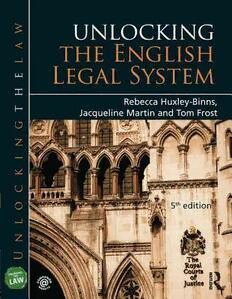
Unlocking the English Legal System PDF
Preview Unlocking the English Legal System
2 UNLOCKING THE LAW UNLOCKING THE ENGLISH LEGAL SYSTEM 5th edition Rebecca Huxley-Binns, Jacqueline Martin and Tom Frost 3 Fifth edition published 2017 by Routledge 2 Park Square, Milton Park, Abingdon, Oxon OX14 4RN and by Routledge 711 Third Avenue, New York, NY 10017 Routledge is an imprint of the Taylor & Francis Group, an informa business © 2017 Rebecca Huxley-Binns, Jacqueline Martin and Tom Frost The right of Rebecca Huxley-Binns, Jacqueline Martin and Tom Frost to be identified as authors of this work has been asserted by them in accordance with sections 77 and 78 of the Copyright, Designs and Patents Act 1988. All rights reserved. No part of this book may be reprinted or reproduced or utilised in any form or by any electronic, mechanical or other means, now known or hereafter invented, including photocopying and recording, or in any information storage or retrieval system, without permission in writing from the publishers. Trademark notice: Product or corporate names may be trademarks or registered trademarks, and are used only for identification and explanation without intent to infringe. First edition published by Hodder Education 2005 Fourth edition published by Routledge 2014 British Library Cataloguing in Publication Data A catalogue record for this book is available from the British Library Library of Congress Cataloging in Publication Data Names: Huxley-Binns, Rebecca, author. | Martin, Jacqueline, 1945- author. | Frost, Tom (Lecturer in Law) author. Title: Unlocking the English legal system/Rebecca Huxley-Binns, Jacqueline Martin, Tom Frost. Description: Fifth edition. | New York, NY: Routledge, 2017. | Includes bibliographical references and index. Identifiers: LCCN 2016052444| ISBN 9781138228405 (hardback) | ISBN 9781138228412 (pbk.) Subjects: LCSH: Law–England. 4 Classification: LCC KD661 .H89 2017 | DDC 349.42–dc23 LC record available at https://lccn.loc.gov/2016052444 ISBN: 978-1-138-22840-5 (hbk) ISBN: 978-1-138-22841-2 (pbk) ISBN: 978-1-315-39266-0 (ebk) Typeset in Palatino by Wearset Ltd, Boldon, Tyne and Wear Visit the companion website at: www.routledge.com/cw/huxley-binns 5 Contents Acknowledgements Guide to the book Preface List of figures List of abbreviations Table of cases Tables of statutes and other instruments 1 THE SOURCES OF LAW 1.1 The English legal system 1.2 The sources of law 1.3 The courts 1.3.1 The Supreme Court of the UK 1.4 The common law 1.4.1 Problems of the common law 1.4.2 Development of equity 1.5 Parliament 1.5.1 Legislation 1.5.2 The enactment process 1.6 Delegated legislation 1.6.1 Statutory instruments 1.6.2 By-laws 1.6.3 Orders of the Legislative Committee of the Privy Council 1.6.4 Parliamentary control of secondary legislation 1.6.5 Judicial control of secondary legislation 1.7 The European Union 1.7.1 A brief history of the European Union 1.7.2 UK membership of the EU 1.7.3 The role of the Court of Justice of the European Union 6 1.7.4 Effect on parliamentary sovereignty 1.8 European Convention on Human Right 1.8.1 The Human Rights Act 1998 1.9 Law reform 1.9.1 Judges 1.9.2 Parliament 1.9.3 The law reform agencies 1.9.4 Royal Commissions 1.9.5 Academics 1.9.6 Pressure groups 1.9.7 Media pressure 1.9.8 Europe Sample essay question Further reading 2 THE DOCTRINE OF JUDICIAL PRECEDENT 2.1 What is the doctrine of precedent? 2.2 How does the doctrine of precedent operate? 2.2.1 The court hierarchy 2.2.2 Ratio decidendi and obiter dicta 2.2.3 Persuasive precedent 2.3 The doctrine as applied in individual courts 2.3.1 The Supreme Court 2.3.2 The Court of Appeal (Civil Division) 2.3.3 The Court of Appeal (Criminal Division) 2.3.4 The Divisional Court of the High Court 2.3.5 The High Court 2.3.6 The Crown Court 2.3.7 County Courts and Magistrates’ Courts 2.3.8 The Court of Justice of the European Union 2.3.9 The Judicial Committee of the Privy Council 7 2.4 The Human Rights Act 1998 2.5 The declaratory theory 2.6 Avoiding precedents 2.6.1 Distinguishing 2.6.2 Reversing 2.6.3 Overruling 2.7 Pros and cons of precedent Sample essay question Further reading 3 STATUTORY INTERPRETATION 3.1 Introduction 3.1.1 The need for statutory interpretation 3.1.2 Applying the law 3.1.3 Judicial law-making 3.1.4 Interpretation or construction? 3.1.5 Parliamentary definitions 3.2 The three ‘rules’ 3.2.1 The literal rule 3.2.2 The golden rule 3.2.3 The mischief rule 3.3 The purposive approach 3.3.1 European influence 3.4 Literal approach versus purposive approach 3.5 Rules of language 3.5.1 The ejusdem generis rule 3.5.2 Expressio unius est exclusio alterius (the express mention of one thing excludes others) 3.5.3 Noscitur a sociis (a word is known by the company it keeps) 3.6 Presumptions 8 3.7 Intrinsic and extrinsic aids 3.7.1 Intrinsic aids 3.7.2 Extrinsic aids 3.7.3 The use of Hansard 3.7.4 Law reform reports 3.7.5 International conventions 3.8 The effect of the Human Rights Act 1998 Sample essay question Further reading 4 CIVIL COURTS 4.1 Introduction to the courts system 4.1.1 Civil and criminal cases 4.1.2 Superior courts and inferior courts 4.1.3 Appellate courts and trial courts 4.1.4 Courts and tribunals 4.2 Civil courts of trial 4.2.1 Queen’s Bench Division 4.2.2 Chancery Division 4.2.3 Family Division 4.2.4 County Court 4.2.5 Small claims 4.2.6 The track system 4.2.7 Transfer of cases between the County Court and the High Court 4.3 Problems in the civil justice system 4.3.1 The Civil Justice Review 4.3.2 The Heilbron–Hodge Committee 4.4 The Woolf Report 4.4.1 The track system 4.4.2 Civil procedure 4.4.3 Case management 9 4.4.4 Pre-action protocols 4.4.5 Encouraging alternative dispute resolution 4.4.6 Strict timetables 4.4.7 Judgment in default and summary judgment 4.4.8 Part 36 offers to settle 4.4.9 Are the Woolf reforms a success? 4.5 Enforcement of judgment 4.6 Tribunals 4.6.1 Administrative tribunals 4.6.2 Tribunals, Courts and Enforcement Act 2007 4.6.3 Composition and procedure 4.6.4 Advantages and disadvantages of tribunals 4.6.5 Domestic tribunals 4.7 Alternative dispute resolution 4.7.1 Negotiation 4.7.2 Mediation 4.7.3 Conciliation 4.7.4 Online Dispute Resolution 4.7.5 Dispute resolution services 4.7.6 Arbitration 4.7.7 Encouraging the use of alternative dispute resolution Sample essay question Further reading 5 CRIMINAL COURTS AND PROCEDURE 5.1 Introduction 5.2 The Criminal Procedure Rules 5.3 The Crown Prosecution Service 5.3.1 Code for Crown Prosecutors 5.3.2 The Glidewell Report 5.3.3 Victims’ Right to Review 10
